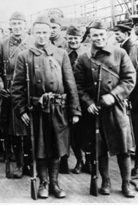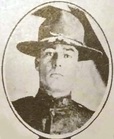|
|
|
|
|
|
 The 369th Experience is in the national spotlight during Black History Month
February is Black History Month, and February 2019 has been a very busy time for telling the story of the African-American heroes of World War I -- and we at the U.S. World War I Centennial Commission are thrilled by the exposure that the Commission-sponsored 369th Experience is getting nationally. Among other high-profile appearances, 369th Experience project leader Stephany Neal, and noted historian (and member of the Commission's Board of Historical Advisors) Dr. Jeffrey Sammons (above) were featured on New York City's ABC 7 "Here and Now" show. Click here to watch the video of that appearance, and get links to other appearances on well-know national programs.
Kansas City Film Premiere Screening of documentary "Pershing's Paths of Glory"

In recognition of the 125th Anniversary of the National Society of Pershing Rifles, the nation's foremost military honor society for ROTC cadets & midshipmen, the Society is hosting a major premiere event in Kansas City, MO, home of the National World War I Museum and Memorial. Pershing's Paths of Glory is a documentary that tells the exceptional story of one of America's greatest military leaders, General John J. Pershing. The story is told by Pershing's living legacy - members of the National Societies of Pershing Rifles, Pershing Angels, and Blackjacks. Click here to read more about this movie, and find out how to get tickets to the premiere event in Kansas City March 15.
|

Even as Germany’s surrender was being signed in a railway car at Compiegne Forest near Paris on November 11, 1918, even as throngs were celebrating in London and New York, Captain Robert Boyd and the men of the U.S. Army’s 339th Infantry Regiment, Company B, were fighting for their lives against hundreds of Bolshevik troops in the snowy, bitterly cold wastes of northern Russia. Writing for the Military History Now web site, historian James Carl Nelson, author of The Polar Bear Expedition: The Heroes of America’s Forgotten Invasion of Russia, 1918-1919, describes the "somewhat bizarre series of events that had brought this contingent of Doughboys to this remote and desolate place: the village of Toulgas on the Dvina River, 150 miles from the relative safety of the frozen port of Archangel on Russia’s northern coast." Click here to get a better understanding of this largely-neglected sideshow of the United States involvement in World War I.
|
American presence in Germany from 1918-1923 had lasting effects on the culture, ideology and politics of the region

Sit in on any WWI history class in U.S. schools today and you probably won’t hear much about the American occupation of Germany that followed the war and lasted until 1923. Arizona State University (ASU) School of International Letters and Cultures German instructor Christiane Reves thinks that should change and hopes an exhibit now on display in the lobby of the Durham Language and Literature building at ASU will help. On the 100th anniversary of the presence of American occupational forces in the regions between Trier and Koblenz, “Stars and Stripes Above the Rhine: The American Occupation in Germany after World War I” aims to educate ASU students, faculty, staff, and the wider community about the laudable and conciliatory interactions between the Americans and the people who were once their military opponents. Click here to read more about this ASU exhibit which illuminates the effects on the culture and ideological history of the region occupied by the American forces.
|

In a guest blog post for the University of California (UC) Food Observer web site, UC researcher Wendi Gosliner shared this observation: “Food waste presents a major challenge in the United States. Estimates suggest that up to 40% of the food produced nationally never gets consumed, causing substantial economic and environmental harms. Wasted food utilizes vast quantities of precious land, water and human resources, yet rather than nourishing people, it feeds landfills, producing methane gasses that poison the environment. Much of the food waste (43%) occurs at the household level." Click here to read how Gosliner thinks a World War I poster has advice we’d be well served to heed today in order to address this issue.
|
From the World War I Centennial News Podcast
Historian's Corner:
Dr. Hal Chase on Fort Des Moines, IA

In February 8th's edition of the World War I Centennial News Podcast, Episode 109, host Theo Mayer spoke with historian and native Iowan Dr. Hal Chase about Fort Des Moines, Iowa, a significant landmark in African American history. Over 600 African American officers were trained and commissioned at Fort Des Moines, before deploying to France. Click here to read a transcript of this insightful interview.
|
100 Years in the Making:
Pangolin Editions' Steve Maule

Episode #111
Highlights: War, Pandemic, Now Famine!
Host: Theo Mayer
In The Headlines This Week - Host | @02:10
War Caused Famine Spreads - Mike Shuster | @07:50
“Y” Girls Serving in War-Torn France - Dr. Edward Lengel | @12:05
100 Years in The Making - Pangolin Editions Foundry - Steve Maury | @18:40
Remembering Veterans - 369th Experience Band Concert - From Video | @25:55
Historians Corner - African American Nurses - Dr. Charissa Threat | @36:20
Speaking WWI - Barnstorming - Host | @44:10
Highlights from the Dispatch Newsletter - Host | @49:00
More....
|

The Story of Freddie Stowers, the First African American Recipient of the WWI Medal of Honor
By Courtney L. Tollison Hartness, Ph.D.
While researching African Americans who served in the WWI American Expeditionary Forces (AEF) from her community, oral historian and Furman history professor Courtney L. Tollison Hartness discovered the compelling story of one soldier whose influential and enduring legacy would have been inconceivable to him.
September 28, 2018, marked the centennial of his death. His name was Freddie Stowers, and he was the first African American Recipient of the WWI Medal of Honor. Yet he didn't receive the award until 73 years after he perished during the Battle of Meuse-Argonne. Read Tollison Hartness' account of uncovering Stowers' legacy this week at WWrite!
|

A man is only missing if he is forgotten.
Monday's Doughboy MIA this week is Private Wesley J. Creech. Born 15MAR1886, in Hallsboro, North Carolina, Wesley Jackson Creech was the fourth of six children that Henry and Martha Creech would rear. He signed his 05JUN1917 draft card at Bolton, North Carolina, where he listed himself as a lumber inspector and two months later married Miss Francis Williamson, age 19. Creech received his draft call shortly thereafter, reporting for duty on 01OCT1917 and was sent to Camp Jackson for induction. From there he went to Camp Sevier for infantry training and was placed in Company C, 120 th Infantry Regiment, 30 th ‘Old Hickory’ Division. Departing Boston, Massachusetts for overseas service on 12May1918 aboard the transport Bohemian, Creech’s division was brigaded with the British in the Somme sector that summer. Records show Wesley Creech as being killed in action on 31AUG1918 and buried by a British unit, however later identification of his grave by American Graves Registration personnel proved fruitless. As such, he is memorialized on the Tablets to the Missing at the Flanders Field American Cemetery at Waregem, Belgium.
Want to help solve Pvt. Creech’s case? Consider making a donation to Doughboy MIA at www.usww1cc.org/mia. It takes only a moment and your tax deductible contribution can be as large as you want or as small as $10.00 on our ‘Ten for Them’ program. Your contribution helps us make a full accounting of all 4,423 US MIA’s from WWI, and keeps these lost men from being forgotten. Make your tax deductible donation now, with our thanks.
|

World War I Prints from the Pritzker Military Museum & Library
As the United States commemorates the centennial of World War I, one of the nation’s premier military history institutions pays tribute to the Americans who served and the allies they fought beside to defeat a resourceful enemy with a lavishly illustrated book. It is an official product of the United States World War One Centennial Commission. The story of WWI is told through the memorable art it spawned―including posters from nations involved in the conflict―and a taut narrative account of the war’s signal events, its major personalities and its tragic consequences; and the timely period photographs that illustrate the awful realities of this revolutionary conflict. Most importantly, this book is a tribute to those who served in the Army, Navy, Marine Corps and what would become the Air Force. Proceeds from the sale of this book help fund the WW1 Memorial in Washington, DC.
This and many other items are available as Official Merchandise of the United States World War One Centennial.
|

|
|
|
|

Submitted by: Frank M. Seleno {Grand Nephew}
Francesco Di Cresce was born around 1894. Francesco Di Cresce served in World War 1 with the the United States Army. The enlistment was in 1917 and the service was completed in 1918.
Story of Service
Francesco Di Cresce was born in the small hill town of Sora Italy located in the commune of Lazio and the province of Frosinone. Francesco was the 3rd child and oldest boy of seven (7) children of parents Pietro and Lucia Di Cresce (Matacchione).
Older sisters Vincenza (1) , Restitutta (2) and younger brothers Antonio (4) , Giulio/Julius (5), Innocenco (6) and Sante (7). They were considered “contadini”. People who made their living farming. Francesco and Restitutta were close and when young would go to the market in town to sell the tomatoes and zucchini grown by the family. Being called a “contadino” in Italy was not an insult. But in America, the new way of thinking was like this. The moment an Italian peasant sets foot on Ellis Island, he becomes a “Signore”. A gentleman.
|
|
|
|
|